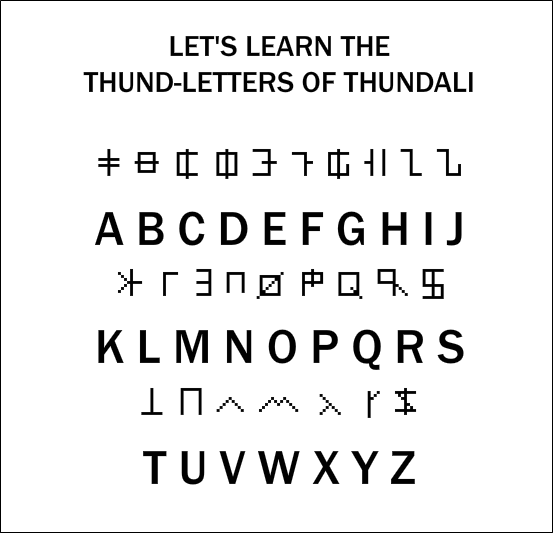
Thundali Language Handbook: Thund-Letters of the Soilmen
Overview of Thundali
Thundali is the primary language of the Soilmen, inhabitants of the mystical planet Thundarr. Their language, vibrant and resonant, revolves around powerful symbols called Thund-Letters, each carrying elemental significance. Thundali is a tonal language, with subtle intonations that affect meaning and emotion. Thund-Letters are written vertically, each designed to channel specific energy and meaning, a unique quality that aligns with the soilmen’s deep connection to the natural forces of their planet.
Thund-Letters & the Thundali Language of Planet Thundarr
Thundali is the primary language spoken across Planet Thundarr, used by soilmen and various inhabitants of its six regions. The writing system, known as Thund-Letters, is unique to the planet and has distinct characteristics that reflect the culture and history of Thundarr’s people.
Thund-Letters: The Writing System
Thund-Letters is an alphabetic script, but it has influences from ancient pictographs found in Thundarr Desert ruins. It consists of 24 main letters, categorized into three groups:
- Solar Letters (8): Inspired by the Thundarr Sun, these letters have circular, radiant, or curved shapes. They are often associated with light, leadership, and energy.
- Lunar Letters (8): Derived from the Moon of Thundarr, these letters have crescent-like or softer forms. They represent wisdom, secrecy, and the night.
- Elemental Letters (8): Rooted in Thundarr’s natural forces (water, fire, air, earth), these letters have jagged or flowing strokes, reflecting their chaotic or stable nature.
Additional Marks:
- Thunder Mark ( 〆 ): Used to indicate strong emphasis, like shouting or commands.
- Echo Dashes (~): Placed after a word to indicate an echo or repeated concept.
- Silent Star (*): Marks silent letters in borrowed words.
Thundali Language Essentials
1. Sentence Structure:
Thundali follows a Verb-Subject-Object (VSO) structure in formal writing but allows Subject-Verb-Object (SVO) in casual speech.
Example:
- Formal: “Runs Falcon the skies.” (Meaning: The Falcon flies across the skies.)
- Casual: “The Falcon runs the skies.”
2. Pronouns:
- I/Me: Zho
- You: Tha
- He/She/They: Ro
- We/Us: Zhon
- They (plural): Rohn
3. Key Phrases:
- “Thundarr Forever!” – Tandur Zho’kar! (A patriotic expression)
- “Where is the sea?” – Dira thun-norh?
- “I am Falcon.” – Zho fal-Kann.
4. Unique Sounds:
Thundali has a deep, resonant “Thun” sound that is used in many words, reflecting the planet’s name. The “rr” sound is often a growl, indicating power or strength.
5. Writing Direction:
Thund-Letters are written horizontally from left to right, but ancient inscriptions in Thundarr Desert often feature vertical writing, hinting at an old tradition.
Cultural Impact of Thundali
- Thundarr City dialect is fast-paced and has many abbreviations.
- Thundarr Forest preserves the oldest forms of Thundali, resembling chants and poetic speech.
- DEC (Defense Enforcement Centre) has a coded version of Thundali used for military communications.
- The Clown’s criminal networks use Thundali backward to hide meanings in secret messages.
Key Components of Thund-Letters
- Core Thund-Letters (Elements) Each Thund-Letter is associated with one of Thundarr’s primary elements, acting as both a phonetic sound and an energy conduit.
- Ra (Fire): Represents warmth, energy, and life; phonetically it resembles a deep “Raaa” sound.
- Za (Water): Symbolizes fluidity and adaptability; pronounced like “Zaaa” with a soft yet continuous tone.
- Mith (Earth): The foundational sound with a stable “Mmmith” hum, symbolizing grounding and stability.
- Gul (Air): Represents movement and breath, whispered as “Guuul” with a faint, airy tone.
- Vash (Ether): Resonates a transcendental vibration, pronounced “Vaaaaash,” carrying otherworldly energy.
- Modifiers and Tones Thundali is a tonal language, where slight shifts in tone or pitch add layers of meaning. Ascendant, neutral, and descendant tones are used:
- Ascendant: Rising pitch, adds urgency or energy.
- Neutral: Flat, calm pitch, used for statements and stability.
- Descendant: Falling pitch, implies closure, sadness, or finality.
- Thund-Letter Script Style Each Thund-Letter is inscribed with a single stroke and a unique curve or edge, reflecting its elemental nature:
- Fire (Ra): Sharp, angular strokes with a slight upward curve at the end.
- Water (Za): Flowing, continuous line, sometimes looping like a gentle wave.
- Earth (Mith): Broad strokes with a solid base, squared at the bottom.
- Air (Gul): Feathered, lightly dotted strokes, resembling dispersing dust.
- Ether (Vash): A circular, spiraling pattern with a central dot representing the spirit core.
- Word Formation and Syntax
- Roots and Endings: Each word has a root Thund-Letter followed by a secondary Thund-Letter to modify meaning.
- Syntax Order: Thundali is generally SVO (Subject-Verb-Object) but shifts to OSV for emphasis, especially in ceremonial speech.
- Connector Glyphs: Small symbols link words to indicate relationships, adding nuance without altering root meanings.
- Common Thundali Phrases
- Ra-Za-Gul (The Light Breathes): Used to express life’s continuation.
- Mith-Vash (The Ground and Spirit): A greeting among Soilmen, symbolizing unity.
- Za-Ra-Mith (Water-Heat-Earth): Refers to renewal and growth, often used in blessings for fertile soil.
- Magical Resonances Soilmen often use Thund-Letters in rituals, believing the spoken and written forms hold power to influence nature. Soilmen inscribe Thund-Letters on objects or chant them in tones to evoke elemental responses, such as summoning rain with “Za-Gul” or calming earth with “Mith-Mith.”
Usage Tips
- Keep tones precise; subtle shifts affect meanings.
- Embrace the flow of Thundali; each syllable carries the planet’s energy.
- Respect Thund-Letters as sacred symbols—each is considered a gift from Thundarr’s elemental forces.
Conclusion
This guide captures the essentials of Thund-Letters and the Thundali language. To master it, immerse in its elements, and honor the legacy of Thundarr’s soilmen.
Scene: A Moonlit Cliff Overlooking the Thundarr Sea
(Faro Faros and Rita Faros stand on a rocky cliff, gazing at the moon reflecting over the vast waters of the Thundarr Sea. A cool breeze brushes past them as they converse in the ancient Thundali tongue.)
Faro: Dira thun-norh? (Where is the sea?)
Rita: Thun-norh dira jharn’ro. (The sea is before us.)
Faro: Zho fal-Kann. (I am Falcon.)
Rita: (smirks) Ro fal-Kann, zho Shecon. (You are Falcon, I am Shecon.)
Faro: (grinning) Thra’ron fal-Kann Shecon. (Adventures call Falcon and Shecon.)
Rita: Tandur Zho’kar! (Thundarr Forever!) (Raises her fist to the sky.)
Faro: Tandur Zho’kar! (Echoes, feeling the weight of their legacy.)
(The wind howls louder as if answering their voices. The sea below crashes against the cliffs, its waves carrying the unbreakable spirit of Thundarr’s heroes.)

